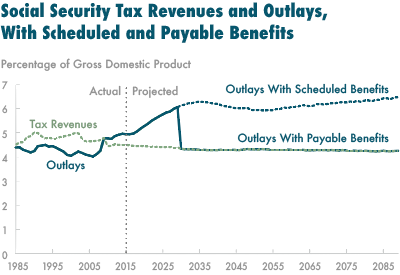In conjunction with its recently updated projections for Social Security’s finances, the Congressional Budget Office has released a menu of reform options for social security.
Given how large a deficit the CBO projects for Social Security – 4.4% of payroll over 75 years, nearly twice as large as the shortfall porjected by the Social Security Trustees – the task of putting together a package of reforms that would balance Social Security’s finances has gotten tougher.
Click here to check it out.




1 comment:
The CBO estimates
"If current laws governing Social Security taxes and benefits stay generally the same and if all benefits are paid in full—an assumption that underlies CBO’s extended baseline projections—outlays for the Social Security program will exceed non interest revenues by almost 30 percent in 2025 and by more than 40 percent in 2040.'
If outlays for social security exceed non-interest revenues by 40% in 2040, what is the payable benefit in 2040? Does this mean benefits would be paid at 60% of scheduled benefits under current law? In addition by 2025 it states outlays will exceed revenues by 30%, again does this mean under the CBO estimate that payable benefits are 70% of scheduled benefits.
The SSA projects paying over 75% in 2034. This is a wide variation in projections.
In reality when expenses exceed income by 40%, this equates to a payable benefit of 71%. For every $100 of income, SSA's projected expenses under current law are $140 or 40% more. However, SSA can only pay $100 instead of $140 so the payable benefit is $100/$140 or 71%.
What happens later on like 2050 and 2060 as the worker to beneficiary ratio drops? The payable benefit continues to drop below 71%.
So changes are being proposed.
The taxation of earnings,
The benefit formula,
The full retirement age (FRA),
Cost-of-living adjustments (COLAs), and
Benefits for specific groups.
The changes are nothing different than when Kellogs keeps the same size box, but reduces the amount inside the box for the same price. It is called repackaging.
These potential changes does not change the overall amount of the benefit nor the cost to the worker. You cannot get something from nothing.
Post a Comment